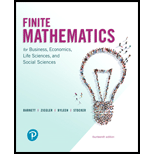
Solve the following minimization problem by maximizing the dual problem (see Matched Problem 1):
Want to see the full answer?
Check out a sample textbook solution
Chapter 6 Solutions
FINITE MATH.F/BUS,ECON,LIFE..-ACCESS
Additional Math Textbook Solutions
Pre-Algebra Student Edition
A Problem Solving Approach To Mathematics For Elementary School Teachers (13th Edition)
Elementary Statistics
Elementary Statistics (13th Edition)
Elementary Statistics: Picturing the World (7th Edition)
- Find the following limit or state that it does not exist. x² +x-20 lim x-4 x-4 Select the correct choice below and, if necessary, fill in the answer box to complete your choice. A. lim x²+x-20 x-4 (Type an exact answer.) x→4 B. The limit does not exist.arrow_forwardDetermine the intervals on which the following function is continuous. f(x) = x - 5x + 6 2 X-9 On what interval(s) is f continuous? (Simplify your answer. Type your answer in interval notation. Use a comma to separate answers as needed.)arrow_forwardFind the following limit or state that it does not exist. 2 3x² +7x+2 lim X-2 6x-8 Select the correct choice below and, if necessary, fill in the answer box to complete your choice. A. lim 3x²+7x+2 6x-8 (Simplify your answer.) X-2 B. The limit does not exist.arrow_forward
- Find the following limit or state that it does not exist. X-2 lim x-2 5x+6 - 4 Select the correct choice below and, if necessary, fill in the answer box to complete your choice. O A. lim X-2 X-2 15x+6 = (Type an exact answer.) - 4 B. The limit does not exist.arrow_forward(a) Sketch the graph of a function that is not continuous at 1, but is defined at 1. (b) Sketch the graph of a function that is not continuous at 1, but has a limit at 1. (a) Which of the following graphs shows a function that is not continuous at 1, but is defined at 1. ○ A. Ay ✓ B. 5 X ✓ (b) Which of the following graphs shows a function that is not continuous at 1, but has a limit at 1. ○ A. B. X y 5- -5 5 ✓ ✓ 5 ☑ 5 X y ☑ LVarrow_forwardIf lim f(x)=L and lim f(x) = M, where L and M are finite real numbers, then what must be true about L x-a x-a+ and M in order for lim f(x) to exist? x-a Choose the correct answer below. A. L = M B. LMarrow_forward
- Determine the following limit, using ∞ or - ∞ when appropriate, or state that it does not exist. lim csc 0 Select the correct choice below, and fill in the answer box if necessary. lim csc 0 = ○ A. 0→⭑ B. The limit does not exist and is neither ∞ nor - ∞.arrow_forwardQ1: For, 0 <|z| < 1, evaluate the following integral where g is analyfunction inside and on the unit circle C: α) δε a) Sc 15 αξί b) Sc 9(5) -1/2 d. -2 1.'s integrale عناarrow_forwardQ4: State the Fundamental Theorem of Independent of Path and Morera's Theorem. Why can't apply these theorems to compute the integral contour. zdz, where C is closedarrow_forward
- Is the function f(x) continuous at x = 1? (x) 7 6 5 4 3 2 1 0 -10 -9 -8 -7 -6 -5 -4 -3 -2 -1 0 1 2 3 4 5 6 7 8 9 10 -1 -2 -3 -4 -5 -6 -71 Select the correct answer below: The function f(x) is continuous at x = 1. The right limit does not equal the left limit. Therefore, the function is not continuous. The function f(x) is discontinuous at x = 1. We cannot tell if the function is continuous or discontinuous.arrow_forward18.11. If f(z) is analytic and |f(z)| ≤1/(1-2) in || < 1, show that |f'(0)| ≤ 4.arrow_forwardQuestion Is the function f(x) shown in the graph below continuous at x = -5? f(z) 7 6 5 4 2 1 0 -10 -6 -5 -4 1 0 2 3 5 7 10 -1 -2 -3 -4 -5 Select the correct answer below: The function f(x) is continuous. The right limit exists. Therefore, the function is continuous. The left limit exists. Therefore, the function is continuous. The function f(x) is discontinuous. We cannot tell if the function is continuous or discontinuous.arrow_forward
 Algebra: Structure And Method, Book 1AlgebraISBN:9780395977224Author:Richard G. Brown, Mary P. Dolciani, Robert H. Sorgenfrey, William L. ColePublisher:McDougal Littell
Algebra: Structure And Method, Book 1AlgebraISBN:9780395977224Author:Richard G. Brown, Mary P. Dolciani, Robert H. Sorgenfrey, William L. ColePublisher:McDougal Littell Algebra for College StudentsAlgebraISBN:9781285195780Author:Jerome E. Kaufmann, Karen L. SchwittersPublisher:Cengage LearningAlgebra & Trigonometry with Analytic GeometryAlgebraISBN:9781133382119Author:SwokowskiPublisher:Cengage
Algebra for College StudentsAlgebraISBN:9781285195780Author:Jerome E. Kaufmann, Karen L. SchwittersPublisher:Cengage LearningAlgebra & Trigonometry with Analytic GeometryAlgebraISBN:9781133382119Author:SwokowskiPublisher:Cengage


